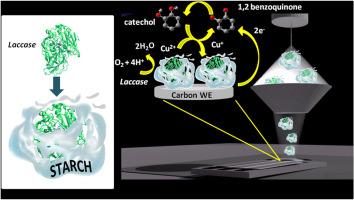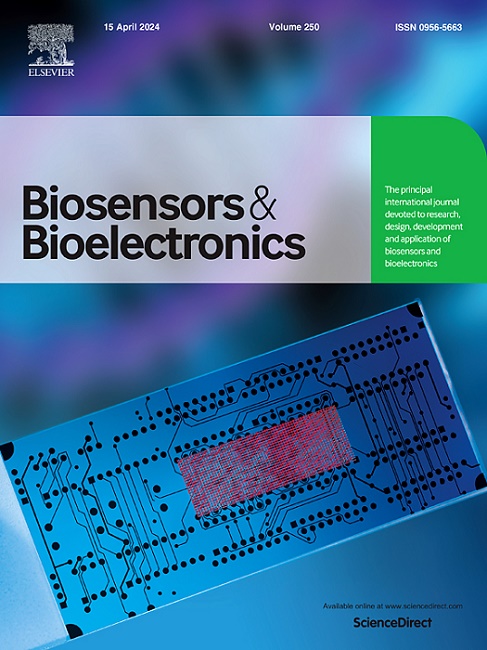电喷雾沉积含淀粉的漆酶:低成本、环保型生物传感器的绿色技术
IF 10.7
1区 生物学
Q1 BIOPHYSICS
引用次数: 0
摘要
最近,利用环境电喷雾沉积(ESD)技术制造出了一种基于漆酶的生物传感器,在检测儿茶酚化合物方面具有前所未有的重复使用和储存能力。这些生物传感器显示,在室温和压力下制备的同一电极可重复使用 63 次测量。在这项新工作中,通过使用不同的化学物理方法分析商用漆酶样品,研究了这种高性能功能背后的原因:电泳、傅立叶变换红外光谱、X 射线荧光和核磁共振光谱。分析结果表明,样品中含有淀粉,而且淀粉作为稳定剂发挥着重要作用。事实上,比较基于淀粉/漆酶的生物传感器和基于不含淀粉/漆酶的生物传感器的性能(两者都是通过 ESD 生产的)发现,不含淀粉的生物传感器仅在第一次水洗后就损失了约 40% 的性能。这表明,漆酶样品中淀粉的存在是提供高耐洗性和耐储存性的关键因素,而高耐洗性和耐储存性是制造此类装置的必要条件。本文章由计算机程序翻译,如有差异,请以英文原文为准。

Electrospray deposition of starch-containing laccase: A green technique for low-cost and eco-friendly biosensors
Recently a laccase-based biosensors with unprecedented reuse and storage capabilities in the detection of catechol compound has been manufactured using ambient Electrospray Deposition (ESD) technique. These biosensors showed to be reused up to 63 measurements on the same electrode just prepared at room temperature and pressure. In this new work the reasons behind such a high-performance functioning have been investigated by analysing the commercial sample of laccase with different chemical physics methods: Electrophoresis, Fourier Transform Infrared Spectroscopy, X-ray Fluorescence and Nuclear Magnetic Resonance Spectroscopy. The analyses reveal the presence of the starch in the sample and its essential role as stabilizing agent. Indeed, comparing the performance of starch/laccase-based biosensors with starch-free/laccase-based biosensors, both produced via ESD, showed that the starch-free biosensors lost about 40% of their performance after just the first wash. This suggests that the presence of starch in the laccase sample is a key factor in providing the high wash and storage resistance, which are essential for the fabrication of such devices.
求助全文
通过发布文献求助,成功后即可免费获取论文全文。
去求助
来源期刊

Biosensors and Bioelectronics
工程技术-电化学
CiteScore
20.80
自引率
7.10%
发文量
1006
审稿时长
29 days
期刊介绍:
Biosensors & Bioelectronics, along with its open access companion journal Biosensors & Bioelectronics: X, is the leading international publication in the field of biosensors and bioelectronics. It covers research, design, development, and application of biosensors, which are analytical devices incorporating biological materials with physicochemical transducers. These devices, including sensors, DNA chips, electronic noses, and lab-on-a-chip, produce digital signals proportional to specific analytes. Examples include immunosensors and enzyme-based biosensors, applied in various fields such as medicine, environmental monitoring, and food industry. The journal also focuses on molecular and supramolecular structures for enhancing device performance.
 求助内容:
求助内容: 应助结果提醒方式:
应助结果提醒方式:


